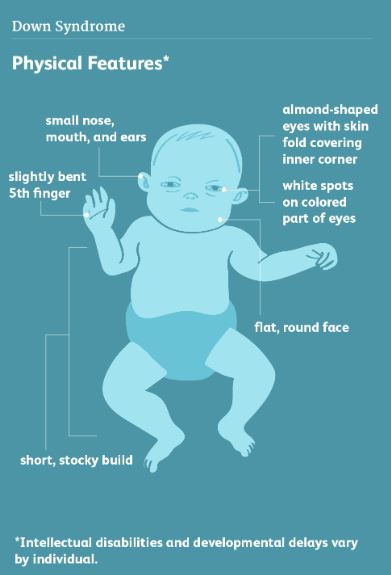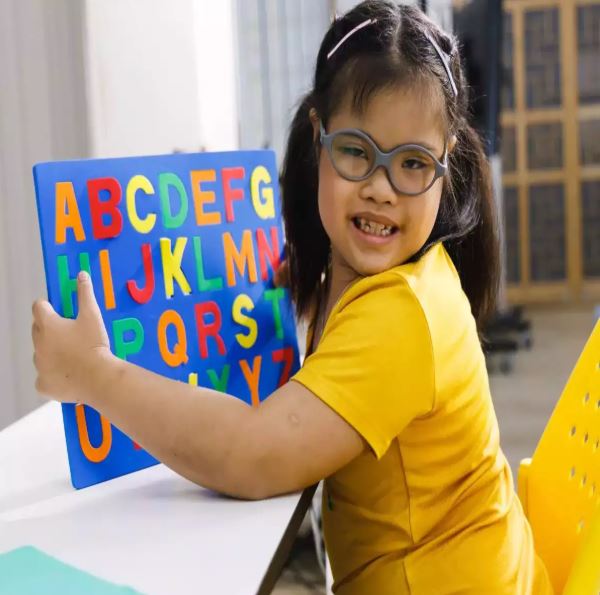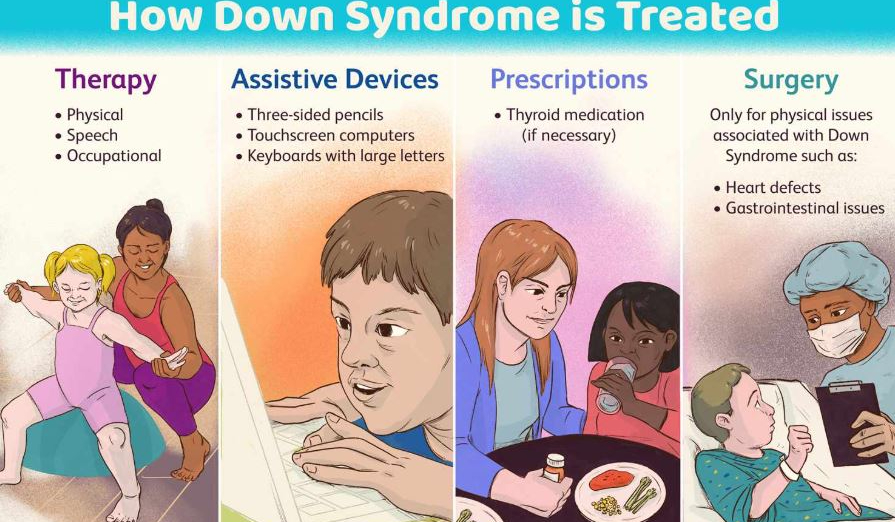Down Syndrome: Embracing Differences, Building an Inclusive and Supportive Society
Intellectual disabilities (ID) affect millions of people worldwide and can arise from genetic, environmental, or any other unknown factors. Among various forms of Intellectual disabilities, Down syndrome is one of the well-known genetic deformities, accounting for more than 15–20% of the total intellectual disability population worldwide.

Down syndrome, also known as Trisomy 21, is a genetic condition where a person is born with an extra copy of chromosome 21. This means that they have a total of 47 chromosomes instead of 46. Every year, World Down Syndrome Day is observed on March 21 to spread awareness about this genetic condition, advocate for the rights of those affected with this condition, and work towards their inclusion in mainstream society. The first World Down Syndrome Day was observed in 2006. Eventually, the United Nations General Assembly adopted March 21 as World Down Syndrome Day in 2012. The date, March 21 (3/21), was chosen to symbolize Trisomy 21, the genetic cause of Down syndrome.
In this article, we will explore this condition and will also highlight the care and support that is essential for optimum growth of people with Down syndrome.
In every human cell, the nucleus houses genetic material organized into genes, which determine inherited traits. These genes are arranged along rod-like structures called chromosomes. Normally, each cell contains 23 pairs of chromosomes, with one set inherited from each parent. Down syndrome occurs when an individual has a full or partial extra copy of chromosome 21.
This additional genetic material impacts development, leading to the distinct characteristics associated with Down syndrome. Common physical traits include low muscle tone, small stature, an upward slant of the eyes, and a single deep crease across the palm. However, each person with Down syndrome is unique and may exhibit these traits to varying degrees or not at all.

In the late 19th century, John Langdon Down, an English physician, became the first to accurately describe Down syndrome. His 1866 publication distinguished the condition as a separate medical entity, earning him recognition as the "father" of the syndrome. Although its characteristics had been observed before, Down's work provided the first comprehensive definition of the disorder.In recent years, advancements in medicine and science have allowed researchers to gain deeper insights into Down syndrome. In 1959, French physician Jérôme Lejeune discovered that Down syndrome was a chromosomal condition, noting that individuals with the disorder had 47 chromosomes instead of the typical 46. Further research revealed that the presence of an extra partial or complete copy of chromosome 21 is responsible for the condition’s characteristic traits.
A major breakthrough came in 2000, when an international team of scientists successfully mapped and cataloged all 329 genes on chromosome 21. This milestone paved the way for significant progress in Down syndrome research, leading to a better understanding of the condition and potential advancements in treatment and care.

There are different types of Down syndromes
Trisomy 21 (Nondisjunction): Down syndrome is usually caused by an error in cell division called nondisjunction. Nondisjunction results in an embryo with three copies of chromosome 21 instead of the usual two. Prior to or at conception, a pair of 21st chromosomes in either the sperm or the egg fails to separate. As the embryo develops, the extra chromosome is replicated in every cell of the body. This type of Down syndrome, which accounts for 95% of cases, is called trisomy 21.
Mosaicism: Mosaicism (or mosaic Down syndrome) is diagnosed when there is a mixture of two types of cells, some containing the usual 46 chromosomes and some containing 47. Those cells with 47 chromosomes contain an extra chromosome 21. Mosaicism is the least common form of Down syndrome and accounts for only about 2% of all cases of Down syndrome (Facts about Down syndrome, 2021). Research has indicated that individuals with mosaic Down syndrome may have fewer characteristics of Down syndrome than those with other types of Down syndrome.
Translocation: In translocation, which accounts for about 3% of cases of Down syndrome, the total number of chromosomes in the cells remains 46; however, an additional full or partial copy of chromosome 21 attaches to another chromosome, usually chromosome 14 (Facts and Down syndrome, 2021). The presence of the extra full or partial chromosome 21 causes the characteristics of Down syndrome.
Regardless of the type of Down syndrome, all individuals with the condition have an extra portion of chromosome 21 present in some or all of their cells. However, the exact cause of this additional genetic material remains unknown.
Down syndrome affects people of all races and socioeconomic backgrounds, though the likelihood of having a child with the condition increases with maternal age. A 35-year-old woman has approximately a 1 in 350 chance of conceiving a baby with Down syndrome, which increases to 1 in 100 by age 40 and about 1 in 30 by age 45. However, maternal age does not appear to influence the risk of translocation Down syndrome.
As more couples delay parenthood, the incidence of Down syndrome conceptions is expected to rise, making genetic counseling increasingly important.
Although all three types of Down syndrome are genetic disorders, only 1% of cases have a hereditary component, meaning they are passed from parent to child. Trisomy 21 (nondisjunction) and mosaicism occur randomly and are not inherited. However, in about one-third of translocation cases (which account for 1% of all Down syndrome cases), there is a hereditary link.
Diagnosis of Down syndrome
It can be diagnosed in two ways, prenatally and after birth.
Prenatal Diagnosis
There are two types of prenatal tests for Down syndrome: screening tests and diagnostic tests.
Screening tests assess the likelihood that a fetus has Down syndrome but do not provide a definitive diagnosis. They estimate probability based on various factors.
Diagnostic tests, however, can confirm the presence of Down syndrome with almost 100% accuracy.
A wide range of prenatal screening tests is now available for expectant parents. Most involve a blood test and an ultrasound (sonogram). Blood tests (serum screening tests) measure specific substances in the parent's blood, which, combined with age, help estimate the likelihood of Down syndrome. These tests are often paired with a detailed ultrasound to look for certain markers that may be linked to the condition. Advanced prenatal screening methods can now detect fetal chromosomal material circulating in the parent's blood, offering high accuracy. However, while these tests are highly reliable, they do not provide a definitive diagnosis.
To confirm a prenatal diagnosis, two procedures are available:
Chorionic Villus Sampling (CVS) – performed in the first trimester (between 11 and 14 weeks).
Amniocentesis – conducted in the second trimester (between 15 and 20 weeks).
Both procedures are nearly 100% accurate in diagnosing Down syndrome but carry a small risk of miscarriage (up to 1%). Today, prenatal screening and diagnostic testing are routinely offered to expectant parents of all ages.
At Birth
Down syndrome is typically identified at birth based on distinct physical characteristics, such as low muscle tone, a single deep crease across the palm, a slightly flattened facial profile, and an upward slant of the eyes. However, since these traits can also appear in babies without Down syndrome, a chromosomal analysis known as a karyotype is performed to confirm the diagnosis.
To obtain a karyotype, doctors collect a blood sample and examine the baby’s chromosomes by photographing and arranging them based on size, number, and shape. This analysis allows doctors to determine whether an extra copy of chromosome 21 is present, confirming the diagnosis.
Additionally, a more advanced genetic test called fluorescence in situ hybridization (FISH) can provide faster results by visualizing and mapping the genetic material in the individual’s cells, offering a quicker confirmation of Down syndrome.
The Importance of parental counseling
The information about a suspected Down syndrome’s diagnosis, given either before or after birth, has a profound effect on parents. The physician should prepare to communicate the diagnosis as soon as it is reached and, according to several studies, it is preferable to inform parents when the diagnosis is still uncertain. Communication of diagnostic hypotheses ensures, first and foremost, transparency in the doctor-patient relationship, laying the foundation for a solid relationship of trust, which is fundamental in the treatment process. The communication of the uncertain diagnosis, instead, must be part of a truthful and empathetic dialogue between the physician and parents, where there can be time to cut back their fears and provide the appropriate information for this stage, discouraging parents from using other means of information. Secondly, communicating the diagnosis when it is still uncertain ensures a longer time frame for family to understand, to accept and to elaborate the diagnosis and to redirect goals. It is essential to ensure a quiet and private setting for the dialogue. The diagnosis must be communicated to both parents at the same time.
When discussing the challenges of Down syndrome, it’s important to acknowledge that these children require extra care and attention and that most will not achieve full independence in adulthood. However, society is continuously improving support systems to help them live fulfilling lives.
When talking to parents about possible health conditions (comorbidities), it’s best to avoid overwhelming them with long lists of potential issues. Instead, the focus should be on their child’s specific needs first, followed by general information. It’s also important to exclude conditions that can already be ruled out during pregnancy.
When discussing comorbidities, priority should be given to life-threatening conditions that may require immediate medical attention after birth, such as duodenal atresia, tetralogy of Fallot, or heart defects, which can sometimes be detected during pregnancy. Parents should be informed about their characteristics, treatments, and outcomes.
Next, it’s important to address neurodevelopmental delays and intellectual disabilities, as these may affect the child's ability to live independently. Other minor conditions should only be mentioned when necessary—for example, when early screenings or preventive measures (such as monitoring for sleep apnea or cervical X-rays for neck instability) are required. Parents should also feel free to ask about any specific concerns.
Whenever possible, discussions about potential health issues should also include available treatments and expected outcomes. It should be emphasized that intellectual disability is always present, but its severity cannot be determined before birth. However, modern therapies, such as physiotherapy and speech therapy, have led to significant improvements in children's development, skills, and independence.
During our conversation with Dr. Payal from the Care and Control Centre for Speech and Hearing Bhubaneswar, we learned that while there is no specific cure for Down syndrome, various therapies and support programs can help individuals develop their skills and lead fulfilling lives.
Starting therapy as early as possible gives children with Down syndrome the best chance to reach their full potential. While they may achieve the same developmental milestones as other children such as sitting, walking, and talking it often happens at a slower pace. Therapy plays a crucial role in helping them progress and build independence.
Types of Therapy and Support
Each child with Down syndrome has unique needs, and different types of therapies and support can help them thrive.
Physical, Occupational, and Speech Therapy:
Physical therapy helps children strengthen their muscles, improve coordination, and learn to sit, crawl, walk, and move properly. Speech therapy supports communication skills, helping children learn how to speak clearly, understand language, and use alternative communication methods if needed. Occupational therapy focuses on daily life skills, such as learning how to dress, eat, hold objects, write, or even use a computer.
Behavioral Therapy and Counseling:
Some children with Down syndrome may also experience conditions like ADHD, autism, or compulsive behaviors. Behavioral therapy helps manage these challenges by teaching emotional regulation, social skills, and coping strategies.
Specialized Education Services:
Many children with Down syndrome need extra educational support to help them learn effectively. In countries like the U.S., free educational services and assistive devices are available by law until age 21 or until they complete high school. Special education programs focus on personalized learning methods, making it easier for children with Down syndrome to develop academic and life skills.
Social and Recreational Activities:
Participating in sports, arts, and community activities helps children build friendships, gain confidence, and improve social skills.
Job Training and Life Skills Programs:
Many organizations offer job training to help individuals with Down syndrome learn workplace skills and self-care habits, preparing them for independent or supported employment in adulthood.
By combining early intervention, therapy, education, and social support, individuals with Down syndrome can lead meaningful and independent lives to the best of their abilities.
In Bhubaneswar, there are several centers and specialists offering care and therapy for individuals with Down syndrome and intellectual disabilities. Some of the notable organizations being;
AIIMS Bhubaneswar Perinatal Clinic Bhubaneswar, provides comprehensive genetic counseling and support services, including cytogenetic testing for conditions like Down syndrome.
Chetana Institute for the Empowerment of Persons with Intellectual Disability in Bhubaneswar, offers special education, vocational training, and rehabilitation services to individuals with intellectual disabilities, including Down syndrome.
Margdarsi Foundation Bhubaneswar, provides specialized speech therapy and personalized care for individuals with Down syndrome, aiming to enhance communication skills.
The Care and Control Centre for Speech and Hearing in Bhubaneswar provides specialized speech and hearing therapy tailored for children with intellectual disabilities. Their programs focus on improving communication skills, auditory processing, and language development in kids.

Helping Children with Down Syndrome Thrive
Being a parent of a child with Down syndrome comes with many valuable lessons—from understanding and managing your emotions to navigating societal expectations and family dynamics. Above all, it is important to support and guide your child so as to help them reach their full potential.
Like all children, kids with Down syndrome flourish in a structured and supportive environment. They respond best to routine and positive reinforcement, making it essential for parents to create a nurturing atmosphere that encourages learning, independence, and social development.
At home, parents can support their child by assigning simple household chores, breaking them into smaller, manageable steps, and being patient throughout the process. It is important for parents to encourage social interactions, setting high but realistic expectations, fosters growth and confidence as children learn new tasks. It is also crucial to dedicate time for play, reading, and family activities, creating opportunities for bonding while reinforcing essential life skills. Encouraging children to perform daily tasks independently, such as dressing, eating, and organizing their belongings, helps build their confidence and self-reliance.
A consistent daily schedule can make daily routines easier for children with Down syndrome. Structuring mornings with clear steps such as waking up, eating breakfast, brushing teeth, and getting dressed helps them navigate the day smoothly. Visual aids like picture charts or simple step-by-step instructions can be beneficial in reinforcing routines. When transitioning from one activity to another, using clear signals like songs or gestures helps ease the shift. Parents should also focus on simple and clear communication, encouraging children to repeat instructions to ensure understanding. Engaging in conversations about their interests can further stimulate language development and interaction.
Supporting a child’s education requires a positive and encouraging approach. Collaboration with teachers, doctors, and therapists should focus on the child’s specific needs rather than just the diagnosis. Parents can reinforce school lessons at home by incorporating them into everyday activities, helping children apply their knowledge in different settings.
Empowering children with decision-making opportunities fosters a sense of independence. Allowing them to choose their clothes or make simple choices in their daily routine gives them a sense of control. While ensuring safety is a priority, parents should also encourage their children to take reasonable risks, helping them understand their capabilities. Guiding them in solving problems whether in social situations or school-related challenges without immediately stepping in to resolve the issue allows them to develop critical thinking and resilience.
By fostering routine, positive reinforcement, and independence, parents can create a supportive environment where children with Down syndrome can thrive. With the right approach, children can build confidence, develop essential life skills, and lead a happy and fulfilling life.

The "neighborhood effect" of Down syndrome
“Neighbourhood effect” highlights the positive impact that a child with Down syndrome can have on their community, influencing social attitudes, promoting acceptance, and increasing awareness about individuals with disabilities. When a child with Down syndrome is part of a neighborhood, it often leads to greater understanding and education about the condition, helping community members recognize their abilities rather than just their challenges. Inclusion in schools and local activities fosters meaningful interactions and friendships, breaking down stereotypes and encouraging social integration. Additionally, families of children with Down syndrome often become advocates for better accessibility, services, and support systems, benefiting not only their own child but also others with special needs in the community. Over time, positive interactions with individuals with Down syndrome can reshape societal attitudes, leading to a more accepting, inclusive, and supportive environment for everyone.
The "neighborhood effect" of Down syndrome varies significantly based on individual differences and the level of engagement a child and their family have within their community. Every person with Down syndrome has unique strengths, abilities, and challenges, meaning their impact on their surroundings will differ. Some children may thrive in social settings, forming close bonds with neighbors and classmates, while others may require additional support to navigate interactions effectively.
However, despite the potential for a positive community impact, challenges may arise. Stigma, discrimination, and lack of awareness can sometimes hinder full inclusion, leading to misunderstandings or social isolation for individuals with Down syndrome. Overcoming these barriers requires ongoing education, advocacy, and open dialogue within the community. Encouraging acceptance, promoting inclusive policies, and creating supportive environments can help ensure that individuals with Down syndrome are valued and given equal opportunities to thrive and participate fully in society.
However, there is still work to be done in eliminating stigma and ensuring that every individual with any physical or intellectual disabilities has access to the resources they need to thrive. By continuing to advocate for educational inclusion, healthcare accessibility, and workplace opportunities, we can create a world where individuals with Down syndrome or any other intellectual disabilities are not only accepted but also empowered to lead fulfilling, independent lives. Through education, compassion, and proactive support, we can build a more inclusive society that values the contributions of all its members.





 copy.jpg)